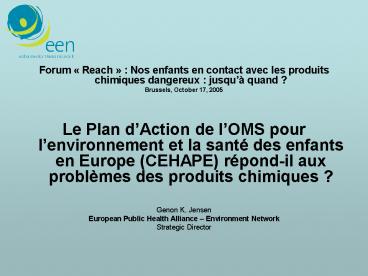Forum - PowerPoint PPT Presentation
1 / 16
Title:
Forum
Description:
Le Plan d'Action de l'OMS pour l'environnement et la sant des enfants en Europe ... m taux lourds), des agents physiques (bruit excessif, par exemple) et des ... – PowerPoint PPT presentation
Number of Views:42
Avg rating:3.0/5.0
Title: Forum
1
- Forum Reach Nos enfants en contact avec les
produits chimiques dangereux jusquà quand ? - Brussels, October 17, 2005
- Le Plan dAction de lOMS pour lenvironnement et
la santé des enfants en Europe (CEHAPE) répond-il
aux problèmes des produits chimiques ? - Genon K. Jensen
- European Public Health Alliance Environment
Network - Strategic Director
2
Who is EEN?
- Created in 2003, pan European umbrella network of
not for profit NGOs from health and environmental
sector. - Health prevention and patient NGOs, health
professionals (doctors, nurses, midwives),
womens groups, consumer groups) - 40 member organisations in 18 countries across
Europe (18 Int/European networks) - Highlight the health dimension of environmental
policy, the costs of pollution and the benefits
of a more sustainable environment - Increase the knowledge and participation of the
health community in EU environmental policy
3
What do we do Advocacy and awareness raising
- Participation in stakeholder groups, conferences,
campaigns - Chemicalreaction www.chemicalreaction.org
- WWF Family Biomonitoring
- Advocacy in European Parliament, Commission,
Council discussions and policy papers, press
releases - Publications
- Childrens environmental health challenges
booklet (2003) - Fact sheet on environmental contaminants and
breastfeeding (English, French and German) - Sick of chemicals booklet (English, German)
- Breast cancer an environmental disease
4
Examples of publications
- www.env-health.org
5
main links between environment and health effects
6
Fourth WHO Ministerial Conference on Environment
and Health, June 2004
- 52 ministers of health and environment from
across Pan European Region - CEHAPE goals 4 Regional Priorities
- Respiratory disease and air quality
- Diseases related to poor water quality and
sanitation - Accidents and urban environment
- Neurodevelopmental and related diseases and
hazardous chemicals
7
Regional Priority Goal 4 on Chemicals
- Nous nous engageons à réduire le risque de
maladies et dincapacités résultant de
lexposition à des substances chimiques
dangereuses (telles que les métaux lourds), à des
agents physiques (bruit excessif, par exemple) et
à des agents bio-logiques, ainsi quà des cadres
de travail dangereux au cours de la grossesse, de
lenfance et de ladolescence. - Nous avons lintention de réduire la proportion
denfants atteints danomalies congénitales, de
retard mental et de troubles du développement et
de faire baisser lincidence des cancers de la
peau (prenant ou non la forme de mélanomes) au
cours de la vie adulte et dautres cancers de
lenfance - a) en adoptant et en faisant respecter des
dispositions législatives et réglementaires, et
en mettant en œuvre des conventions et programmes
nationaux et internationaux qui visent - i) à réduire lexposition des enfants et des
femmes enceintes à des substances chimiques et
agents physiques et biologiques dangereux à des
niveaux qui nont pas deffets néfastes sur la
santé des enfants
8
European Parliamentary briefing hosted by EEN
and WWFBrussels 24th May
Chemical concerns for public health - How
REACH can help Scientific views from Dr Roberto
Bertollini, WHO Director of WHO special programme
on Health and Environment Professor Jonathan
Grigg Professor of Paediatrics, Leicester
University, UK
- CONCLUSIONS
- Data on chemicals needed
- Call for precautionary action
- Right to know about harmful chemicals in products
9
Tip of the toxicity iceberg
10
How CEHAPE addresses uncertainty
- Nous reconnaissons que nous ne comprenons pas
parfaitement la nature et lampleur des effets
sanitaires que lexposition à des agents de
lenvironnement a sur les organismes en
développement, de la période prénatale à
ladolescence. Cependant, eu égard aux données
dont nous disposons déjà sur le rôle de plusieurs
facteurs environnementaux dans lapparition de
maladies et de lésions chez les enfants, et dans
la production deffets qui ne deviennent
manifestes quà lâge adulte, nous devons nous
engager à mener maintenant une action coordonnée
et soutenue pour protéger la santé des enfants,
aujourdhui et dans lavenir. - Article 7, CEHAPE
11
CEHAPE country commitments
- To develop and start the implementation of
national plans by 2007 - To include child-specific actions in the plans
and to setting quantitative targets - To ensure collaboration with all sectors
including new stakeholders - To use new and/or adapting existing national
bodies - To establish new mechanisms that ensure
implementation
12
How can CEHAPE make a difference?
- Working groups
- CEHAPE Task Force
- European Environment and Health Committee (EECH)
- Electronic tools
- Web-based country map with progress and good
examples
13
WHO -- www.who.dk/eehcTo be launched 19 October
14
Example of how countries can report on Regional
Priority Goal
- Chemicals What are the priorities in your
country on reducing childrens exposure to
chemicals - What new policies and measures are underway to
reduce exposure? - Are there measures to protect children against
hazardous chemicals in toys or other household
items? - Are there measures to reduce the risks posed by
building materials, eg asbestos, creosote, flame
retardants etc. - Are the Stockholm, Basel and Rotterdam
Conventions applied? - Is there monitoring of levels of chemical
contaminants in soil, food and water? - Is there monitoring of reproductive health
indicators such as congenital malformations, to
detect potential hazards? - What other international policies or legislation
are important for your country?
15
Next opportunities for political commitment in
practice
- CEHAPE Task Force, October 20-21, 2005
- European Environment and Health Committee,
December 12-13, 2005 - Youth participation
- EEN Childrens Investigation into Chemicals
workshop, November 10, Brussels
16
EPHA Environment Network
- 39-41 Rue dArlons
- B-1000 Brussels
- Belgium
- Tel 32-2 233 38 75
- Fax 32-2 233 38 80
- info_at_env-health.org
- www.env-health.org































